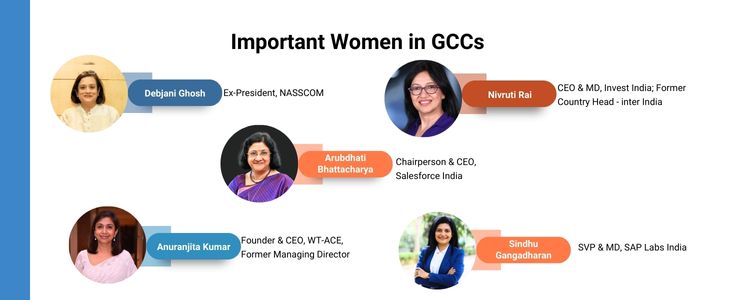
India has over 190 new GCCs in key cities in the last year, and this market is expected to be over $110 billion by 2030. Besides the tech-savvy and volume potential that is an economic prospect of the Indian economy, the diverse workforce potential, especially the employability of women, in the innovation- and white-collar-oriented jobs is also a promising chance for the Indian economy. However, women do not make up as much of the total GCC workforce as of yet in India, which is currently at less than 12% of top-level positions in the workforce. This gap cannot be considered as a social problem as well as a missed economic opportunity. The McKinsey Global Institute estimates that closing the gender gap in the Indian workplaces will increase India’s GDP by 770 US dollars by 2025. This means the future of the Global Capability Centres (GCCs) in India has to be envisaged with the Women lens built in which is safe, smart, and strategically empowering.
Real work safety is systemic, cultural and psychological. As conventional interventions, such as ID-supported entrances, safe cabs, and helpline numbers, still have a place, Women in GCC 3.0 needs further revolution.
The key to unleashing the potential of the female workforce in GCCs lies in designing smart policies that are gender-intelligent.
With hybrid working hours and boundaryless places of work in the future, they need to both physically and virtually resemble the requirements of women.
The next step of GCCs in India is to defend or integrate women not just to become faster but strategic members of organisations as leaders, masterminds and innovators. Global Capability Centres can recode the DNA of the workplace through Women 3.0, without equal talent being just a metric but an attitude.
Collaborate with Inductus GCC in the co-design of women-first work formats—including safety-enabling technology, regulatory flexibility and development-focused inclusion. Design to delivery of GCCs that empower the future of work with women as its leaders.
Inclusion is the origin of the GCC strategy. Leading centers focus on gender diversity, disability inclusion, nerve-class recruitment and LGBTQIA empowerment to speed up innovation and create teams prepared for the future. Yes. According to Nasscom-BCG 2024 data, 78% of Indians work on GCC hybrids or remote-first models, which integrate flexibility, productivity and employee welfare in the main operations. By acting as a cultural bridge, Indian GCCs align regional business requirements with excessive communication, tight structure and multilingual, multicultural teams with global strategies. AI-operated analytics, cloud-elevated platforms, devops, cyber flexibility and digital workplace equipment (e.g., MS Teams, Jira, Zoom, Servicenow) are at the center of digital change in the GCC. Companies have access to huge technical talent pools, operating costs up to 70% of savings, and they avail India’s innovation ecosystem—leading to profit, scale and investment profit (ROI) on speed, scale and investment. Aditi, with a strong background in forensic science and biotechnology, brings an innovative scientific perspective to her work. Her expertise spans research, analytics, and strategic advisory in consulting and GCC environments. She has published numerous research papers and articles. A versatile writer in both technical and creative domains, Aditi excels at translating complex subjects into compelling insights. Which she aligns seamlessly with consulting, advisory domain, and GCC operations. Her ability to bridge science, business, and storytelling positions her as a strategic thinker who can drive data-informed decision-making.
CULTURE: Safety More Than Surveillance
CAPABILITY: Policy as a Performance Enabler
CHANGE: In Infrastructure for Equity
GCC Impact Matrix: From Inclusion to Influence
Element
Women 1.0: Basic Inclusion Phase
Women in GCC 3.0 : Empowerment & Equity Era
Safety
CCTV, transport cabs, ID badges
Tech-enabled safety with psychological assurance: Real-time threat detection apps, mental health integration, AI-based escalation, peer-reviewed incident logs
Flexibility
Work-from-home (WFH) policies, time-offs on request
Life-stage aligned hybrid models: Career-flex grids (maternity, eldercare, IVF cycles), asynchronous work modes, caregiving leaves
Career Pathing
Horizontal mobility, retention-based incentives
Leadership acceleration with returnships: Structured reboarding, AI-driven performance prediction, mid-career mentorship pods, and second-career accelerator programmes
Recognition
Annual awards, Women’s Day events, top-down appreciations
Metric-based equity recognition: Inclusion KPIs on dashboards, caregiver credit systems, team-based equity rewards, non-linear appraisal tracking
Infrastructure
Compliance-based facilities (crèches, separate restrooms)
Human-centric, inclusive design: Period care rooms, wellness pods, quiet zones, sensory-friendly areas, digitally monitored commute tracking zones
Policy Depth
Generic policies with gender mentions
Intersectional HR policy frameworks: LGBTQ+-inclusive, neurodiversity support, gender-fluid benefits, and harassment prevention embedded into OKRs
Tech Enablement
Basic HR portals, hotline numbers
Smart DEI analytics: Bias-checker bots in performance reviews, AI-aided diversity hiring, data-driven burnout detection, and gamified inclusion nudges
Leadership Access
Token appointments, diversity hiring mandates
Pipeline equity design: Sponsorship by CXOs, transparent mobility ladders, “shadow boards” for women in decision-making incubation roles
Audit & Feedback
Annual surveys, exit interviews
Continuous gender audits with third-party benchmarking: Instant DEI dashboards, open-loop grievance redressal systems, and ESG-aligned transparency protocols
Business Impact Focus
CSR-led gender programmes
Productivity and Profitability linkage: Gender-balanced teams outperform by 21% (McKinsey 2023), retention cost savings, innovation rate boost in female-led pods.

Advantage of India in Leading Women in Gcc 3.0
Power Fluid Design, not Just Presence
frequently asked questions (FAQs)

Aditi
Hey, like this? Why not share it with a buddy?
Related Posts
Recent Blog / Post
- Agile Methodologies for GCCs: A Blueprint for Success October 6, 2025
- The Legal and Compliance Checklist for a New GCC Setup October 4, 2025
- The Rise of Niche GCCs: A Focus on Specialised Capabilities October 4, 2025
- The Impact of Regulatory Changes on GCC Operations October 4, 2025
- Cybersecurity for GCCs: A Proactive Approach to Data Protection September 30, 2025
- Beyond Cost: Measuring the True ROI of Your GCC Investment September 29, 2025
- The Future of GCCs in the Retail Sector: A Strategic Playbook September 29, 2025
- David vs Goliath: Mid-Sized GCCs Quietly Outperform the Big Brands September 29, 2025
- Infineon’s Big Bet on India: Inside Its First GCC in GIFT City September 29, 2025
- From Campuses to Capability Centres: How Indian Universities Power the Global GCC Ecosystem September 29, 2025
- Retail Meets Digital: Costco’s GCC in Hyderabad Marks a Global Shift September 29, 2025
- The Silent Crisis: Why Many GCCs Plateau After 3 Years and How to Avoid It September 24, 2025
- Germany’s New Skilled Immigration Act and Its Ripple Effect on the GCC Talent Model September 24, 2025
- From Tokyo to Hyderabad: The Future of GCCs for Japanese Conglomerates September 23, 2025
- GCCs as AI Acceleration Hubs: Collaborating with US and Nordic Tech Majors September 19, 2025
















